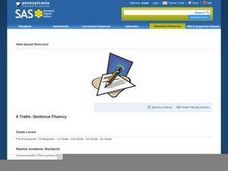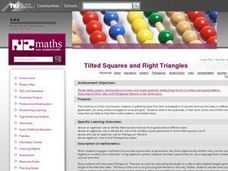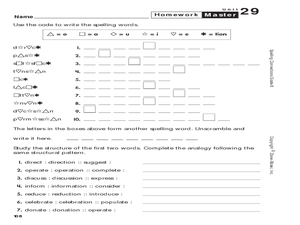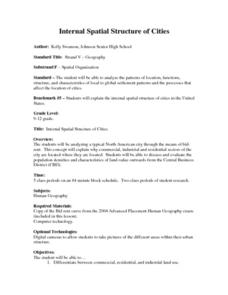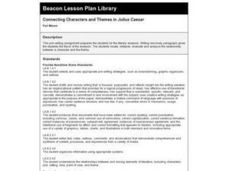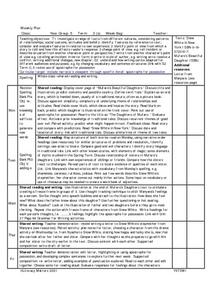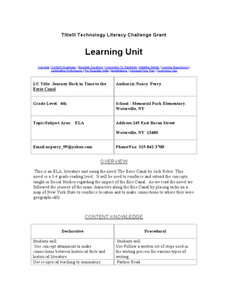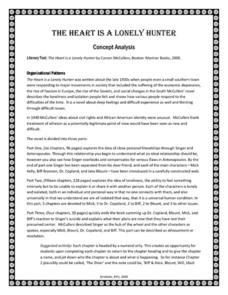Pennsylvania Department of Education
6 Traits: Sentence Fluency
Students practice writing with sentence fluency in order to make the story more enjoyable for the reader. In this sentence fluency lesson plan, students focus on rhythm and flow.
Curated OER
Tilted Squares and Right Triangles
Students investigate squares. They generate patterns from structured situations and find a rule for the general term and express it using words and symbols. Students generate patterns from a rule and substitute values and formulas.
Curated OER
Symbol Code and Spelling Words
In this spelling worksheet, students use a code key with picture symbols to decode ten spelling words. Students decipher each word and print it on the lines.
Curated OER
Those Cells Look Good Enough to Eat
Students explore the parts of the cell. In this cell lesson, students use foods to create cell models that represent the nucleus, cytoplasm, cell membrane, mitochondria, ribosomes, vacuoles, endoplasmic reticulum, and Golgi bodies...
Curated OER
Kites
Students build a kite while integrating math and science. In this kite building lesson, students construct a blueprint and apply mathematical formulas while constructing a kite. They use appropriate flight and kite terminology to...
Curated OER
Where No Student Has Gone Before
Students create a story about an unknown planet invaded by humans as a pre-reading activity for the novel, A Wrinkle In Time. They discuss good versus evil, and identify examples of the theme good vs. evil in books, film, and their own...
Curated OER
Sounding out accuracy, The Sum of the Parts
Young scholars explore word structures by participating in a group activity. In this word segment lesson plan, students collaborate in small groups and pass out cards with certain letters that can form words when put together. Young...
Curated OER
Phonics and Vegetable Books
Students participate in phonemic awareness and phonics activities and develop a list of vegetable vocabulary words. They break up words into beginnings and endings, and trace and write the letter s. Students then create a Vegetable...
Curated OER
Internal Spatial Structure of Cities
Students examine the internal spatial structure of cities. In groups, they analyze patterns of functions, structure and characteristics of settlement patterns. They also identify the population densities of land value of business...
Curated OER
Reading Poetry
Present your class with an overview of poetry-related information. The slides are clearly organized by topic, starting with reading poetry, ending with myths, and touching on everything from the five senses to open and closed forms of...
Curated OER
Dialog Expansion, Structure Drills
Students practice speaking sentence patterns used in classroom dialogs. They use new vocabulary within the sentence patterns.
Curated OER
Lewis Structures
In this Lewis structures worksheet, students identify and describe what Lewis structures or dot diagrams are and how they illustrate the valence electrons in an outer shell. Then they use a periodic table to determine the numbers of...
Curated OER
Unlocking New Words
Students are introduced to the various types of suffixes and prefixes. In groups, they identify the root words and determine the proper suffix or prefix to add to the root. They complete a worksheet and review their answers to end the...
Curated OER
Connecting Characters and Themes in Julius Caesar
Fourth graders prepare for the literary analysis. They locate, interpret, evaluate and analyze the relationship between a character and the theme. After a lecture/demo, 4th graders write topic and detail sentences, then correctly put...
Curated OER
Class Vacation Book
Students, utilizing technology and its avenues, create, produce and publish a variety of works. They generate a bubble map to brainstorm words that describe a specific vacation spot as well as create a pattern book with graphics about...
Curated OER
"Mufaro's Beautiful Daughters"
Fifth graders read and analyze the books "Snow White in New York" and "Mufaro's Beautiful Daughter." They analyze the characteristics of the characters in each story, write thoughts of characters in speech bubbles, and write a letter to...
Curated OER
Erie Canal: Journey Back in Time
Fourth graders read the novel, The Eric Canal, identifying the characters and setting. They respond to daily reading by writing in journals and complete a short answer test upon completion of the novel.
Curated OER
The Great Cafeteria Caper
Students extract DNA from their own hair roots. They run an electrophoresis gel to examine patterns of their DNA along with standard DNA. The experiment is based on a crime scene scenario.
Curated OER
Difference of Squares
Students analyze arithmetic statements. For this difference of squares lesson, students explore patterns and factor the difference of two squares. They compare quantities with integers. Students model and solve equations.
Novelinks
The Heart Is a Lonely Hunter: Concept Analysis
Considering Carson McCullers' The Heart Is a Lonely Hunter for whole-class reading or as a selection for book circles? Check out this resource that overviews the organizational patterns, themes, plot structure, tone, and setting.
Curated OER
Cloze Instruction And Herringbone Technique
Students sort out important information and create a visual framework for reviewing in the future. They organize a large quantity of information thus helping with learning and remembering details, cause and effect, comparison and...
Curated OER
It's Your Opinion
Everyone has a different opinion about the characters they read about in books. Have your class explore forming an opinion and finding evidence to support it as they read and discuss what they think about a particular character. They...
Curated OER
New York City Delights: The Taxi Cab
You set the rate! Step into the shoes of a taxi driver in New York City, and also pretend to be a person who uses taxis to get around town. The class will conduct collaborative research to learn about the history of taxis. Then, they...
Los Angeles Unified School District
Capitalism and Socialism
Capitalism, socialism, communism ... these may seem like a whole bunch of isms to your scholars. High schoolers won't confuse them after completing an informative resource. Your class masters how to use primary sources to critically...


